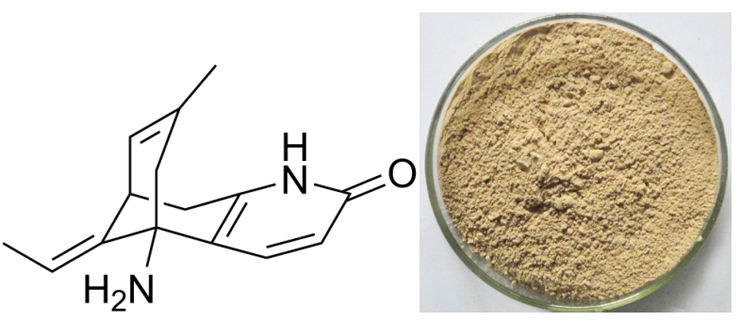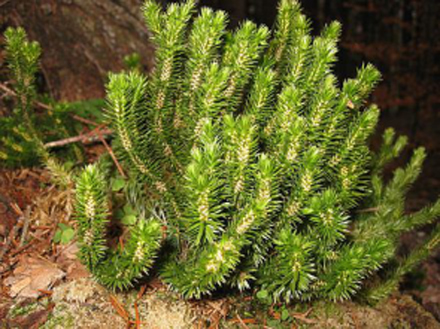Factory Supplier for Huperzine A Factory in Plymouth
Factory Supplier for Huperzine A Factory in Plymouth Detail:
[Latin Name]Huperzia serratum
[Source] Huperziceae whole herb from China
[Appearance]Brown to white
[Ingredient]Huperzine A
[Specification]Huperzine A 1% – 5%, HPLC
[Solubility] Soluble in chloroform, methanol, ethanol, slightly soluble in water
[Particle size] 80 Mesh
[Loss on drying] ≤5.0%
[Heavy Metal] ≤10PPM
[Pesticide residue] EC396-2005, USP 34, EP 8.0, FDA
[Storage] Store in cool & dry area, keep away from the direct light and heat.
[Shelf life] 24 Months
[Package] Packed in paper-drums and two plastic-bags inside.
[What is Huperzine A]
Huperzia is a type of moss that grows in China. It is related to club mosses (the Lycopodiaceae family) and is known to some botanists as Lycopodium serratum . The whole prepared moss was used traditionally. Modern herbal preparations use only the isolated alkaloid known as huperzine A. Huperzine A is an alkaloid found in huperzia that has been reported to prevent the breakdown of acetylcholine, an important substance needed by the nervous system to transmit information from cell to cell. Animal research has suggested that huperzine A’s ability to preserve acetylcholine may be greater than that of some prescription drugs. Loss of acetylcholine function is a primary feature of several disorders of brain function, including Alzheimer’s disease . Huperzine A may also have a protective effect on brain tissue, further increasing its theoretical potential for helping reduce symptoms of some brain disorders.
[Function] Used in alternative medicine, huperzine A has been found to act as a cholinesterase inhibitor, a type of medicine used to prevent the breakdown of acetylcholine (a chemical essential to learning and memory).
Not only used as a treatment for Alzheimer’s disease, huperzine A is also said to enhance learning and memory and to protect against age-related cognitive decline.
In addition, huperzine A is sometimes used to boost energy, increase alertness, and aid in the treatment of myasthenia gravis (an autoimmune disorder that affects the muscles).
Product detail pictures:

Related Product Guide:
The organization upholds the philosophy of "Be No.1 in good quality, be rooted on credit history and trustworthiness for growth", will keep on to provide previous and new customers from home and overseas whole-heatedly for Factory Supplier for Huperzine A Factory in Plymouth , The product will supply to all over the world, such as: Italy, Pretoria, Spain, With the goal of "zero defect". To care for the environment, and social returns, care employee social responsibility as own duty. We welcome friends from all over the world to visit and guide us so that we can achieve the win-win goal together.
Stevia grows best in upland areas in sub-tropical climate. In other places it can be grown as an annual. The plant prefers a lightly textured, well-drained soil to which organic matter has been added. It needs ample water so that the soil is consistently moist, but not wet. In hot, sunny climates it will do best in semi-shade. Propagation is from seed sown in spring, but germination rates can be low-expect half the seeds sown not to germinate. Plant seedlings out once all danger of frost is over. Leaves are best harvested just before flowering. The plants will also grow from cuttings,which are best taken in late winter.The concentration of stevioside in the leaves of Stevia increasing when the plants are grown under long day condition.While, cultivating stevia on a large scale, it can be grown in well-drained red soil and sandy loam soil. The soil should be in the pH range of 6.5-7.5. Saline soils should be avoided to cultivate this plant.
Stevia can be successfully cultivated all around the year all over India expect theareas, which receive snowfall, or temperatures go below 5 degree Celsius in winter.The summer temperatures actually do not affect this plant if the high summer temperatures have already been factored in the cultivation practices.Since seed germination rate is very poor,it is propagated vegetative. Though stem cuttings are used for vegetative tissue culture plants have proven to be the best planting material for Stevia. Tissue culture plants of Stevia are genetically pure, free from pathogens and haveexcellent vigor. The tissue culture plants can be planted throughout the year,expect during peak summer. An ideal planting density is 40,000 plants per acre with spacing of 25×40 cm in a raised bed system. The soil can be enriched with abasal dressing of 25 tons of well rotten farmyard manure/hectare
Soil Type
Stevia requires very good drainage any soil that retain the moisture for very long period of time are unsuitable for Stevia cultivation and should be religiously avoided.Red soil and sandy loam with a 6-7 pH are best for the cultivation of Stevia.
Raised bed preparation
Forming raised beds is the most economical way to grow Stevia. The raised bed should be of 15 cm in height and 60 cm in width. The distance between each plant 23 cm. This would give a plant population of around 40,000 per acre.
Planting Material
There are basically two options for multiplication. The first is the tissue culture and second the stem cutting. Tissue culture is the best option but many farmers are tempted to try the stem cutting method for multiplication. As per practical experience, stem cutting is sometimes more expensive to produce than the tissue culture since the success rate of the stem cuttings establishment is very low, it takes minimum of 25 weeks for the stem cutting to develop in proper feeding roots for transplantation (younger stem cuttings transplants have shown more than 50% mortality in first few weeks of transplants in main field).
Harvesting
Another important aspect of harvesting is the timing of harvest. It should be noted that at no point of time plants should be allowed to flower since after flowering the Stevioside percentage goes down rapidly and leaves are rendered unmarketable. Leaves are harvested by plucking in a small quantity, or the entire plant with the side branches is cut leaving 10 to 15 cm from the base.The first harvesting can be done four to five months after planting. Subsequent harvesting can be done every three months, for five consecutive years. The sweetener in the leaf is maximum till the plant flowers. Just before flowering, the plant should be cut completely leaving 10 cm from the ground. The new flush of leaves will sprout from here. The new plant will be ready for harvest again in three months. The plant yields around 3000 kg of dried leaves from an acre of plantation every year. Harvesting should be done as late as possible, since cool autumn temperatures and shorter days tend to intensify the sweetness of the plants as they evolve into a reproductive state.
Unlocking the sweetness in your harvest
Once all leaves have been harvested it’s required to dry them. This can be
accomplished on a net. The drying process is not one that requires excessive heat;more important is good air circulation. On a moderately warm fall day, stevia crop can be quick dried in the full sun in about 12 hours. (Drying times longer than that will lower the stevioside content of the final product.)
Crushing the dried leaves is the final step in releasing stevia’s sweetening power. The
dried leaves are powdered, sieved and the fine powder is stored in containers. This can be done either by hand or, for greater effect, in a coffee grinder or in a special blender for herbs.
Web: https://www.natureherbs.org | www.natureherbs.co
Email : natureherbs@ymail.com
Watsapp: +91 841 888 5555
Skype: nature.herbs
Click below to find out where to buy the best natural Stevia:
https://www.madronemountain.com/Where to Buy Best Stevia Sweetener
More of us desire to live a wholesome, safer, more natural way of life, and the stevia sweetener provides us the chance to do that without needing to sacrifice whatever we love. Reported to be many hundreds of occasions sweeter than real cane sugars, stevia is really a powerful sweetener which has no calories, and may be used in a lot more moderation than normal sugars. And unlike those nasty synthetic sweeteners, stevia had not been produced in a lab by some scientist. Stevia rebaudiana is really a genus of plant whose simply leaves have already been used as organic sweeteners and for medicinal reasons since way back when.
The first known organic sweetener whose extract may be used as nutritional supplement may be the stevia plant. Its origin will be in SOUTH USA where it is utilized as a sweetener because so many centuries. The swiss botanist Moises Giacomo Bertoni found out it in 1887. It really is up to 300 occasions sweeter than sugar. In the 1950′s the initial cultivation experiments were produced, and from 1970 on, stevia has been cultivated in excellent quantities in Japan. In Europe it really is unapproved still, because of issues that steviol, a breakdown product of the primary component stevioside, will be mutagenic. In the scholarly studies which affirm this thesis, rats received a 1 / 2 of their bodyweight in stevia leaves. If a human being would eat 1 / 2 of his bodyweight in sugars, it wouldn’t be really healthy neither. Which means this study seems fairly untenable as well as the long lasting usage of stevia in SOUTH USA and Japan without the incidents demonstrates stevia is safe. Additionally, there are some scholarly studies that say that it has many positive side effects. But probably a finger is had by the sugar industry in the pie here again. Used as a medicine and sweetener for one thousand years by indigenous Guarani Indians, Today stevia Rebaudiana could very well be the only real known plant to be concerned the sweetener industry. Stevia leaves consist of steviosides, which are chemical substances that trigger Stevia to taste fairly sweet. Stevia will be 200-300 times sweeter than white-colored sugar.
Many of the claims actually got o the extent that herbal substance is from the generation of malignancy. The researchers declare that steviol can quickly convert to a malignancy generating compound. It’s understandable that the scientist are usually divided with this issue and additional study is necessary before a firm declaration is created to solve the question. Although several scientific studies have already been undertaken there continues to be no positive proof that herbal sweetener is truly a danger to your health. In the united kingdom of Japan this herb offers been useful for thirty many years as a sweeten no conclusive evidence has been so long as is has any type of adverse results upon the body. However the FDA firmly facilitates the premise that Stevia can be an unsafe meals additive and because of their governmental placement all Stevia importation as a meals additive has already been banned in America.
Unfortunately it certainly isn’t the scientific proof which is being taken into account here but instead the political clout of the sugars industry which is presently pushing this ban. Stevia is known as a natural item and therefore the sugar companies cannot obtain a patent onto it, preventing the larger corporations from cashing in on its advantages and use. It is obviously a danger to the sugars company’s future at greatest.
For more information on Where to Buy The Best Stevia Leaves? |Is Stevia Leaf The Sugar Alternative for Diabetics? Go to this webpage:
https://www.madronemountain.com/natural-sweeteners/stevia/stevia-side-effects-and-warnings
This article is also related to: healthy sugar alternatives, sugar for diabetics, stevia products, is stevia healthy, stevia safe, stevia plant, best stevia, stevia allergy, stevia health benefits, dangers of stevia
Hope that the company could stick to the enterprise spirit of "Quality, Efficiency, Innovation and Integrity", it will be better and better in the future.







